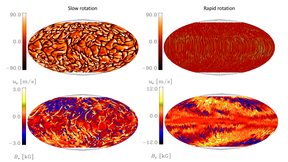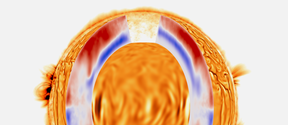Astroinformatics
The group develops and utilises high-performance computing tools for simulating and analysing data from complex (astro)physical systems, such as turbulent fluids, the Sun, interstellar matter in galaxies.

Stellar magnetic activity level and rotation are strongly connected. We studied the effect of increasing rotation rate on solar-like stars using magnetohydrodynamic simulations of stars with outer convective envelopes. At around 1.8 times the solar rotation rate, we found a transition point that separates slowly rotating, magnetically inactive stars, with rather axisymmetric large-scale magnetic fields (like our Sun), from more active, rapidly rotating, stars, with nonaxisymmetric large-scale magnetic fields. In the slow rotators we detected latitudinal dynamo waves reminiscent of the butterfly diagram of the Sun, while in the rapid rotators longitudinal dynamo waves were found. This essentially means that the nonaxisymmetric magnetic field modes rotate with a different speed than the stellar surface, that manifests itself as either prograde or retrograde migration of the magnetic structure. Such behaviour has also been observationally seen in active stars.
Our results also highlight the importance of maintaining high enough supercriticality of convection, in particular, in the rapid rotation regime, where a too low supercriticality results in axisymmetric field configuration instead of a nonaxisymmetric one.

The group develops and utilises high-performance computing tools for simulating and analysing data from complex (astro)physical systems, such as turbulent fluids, the Sun, interstellar matter in galaxies.

cs.aalto.fi